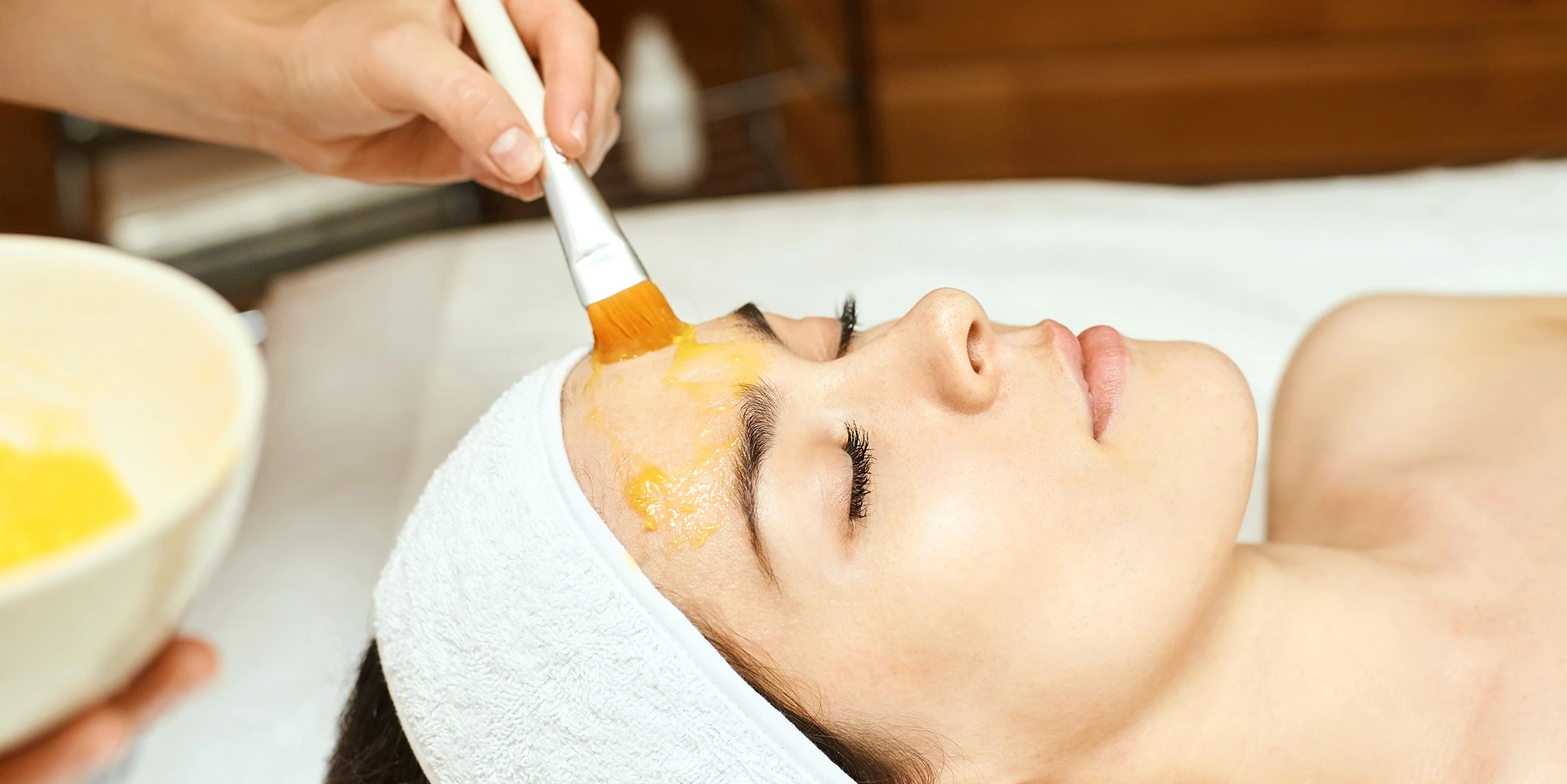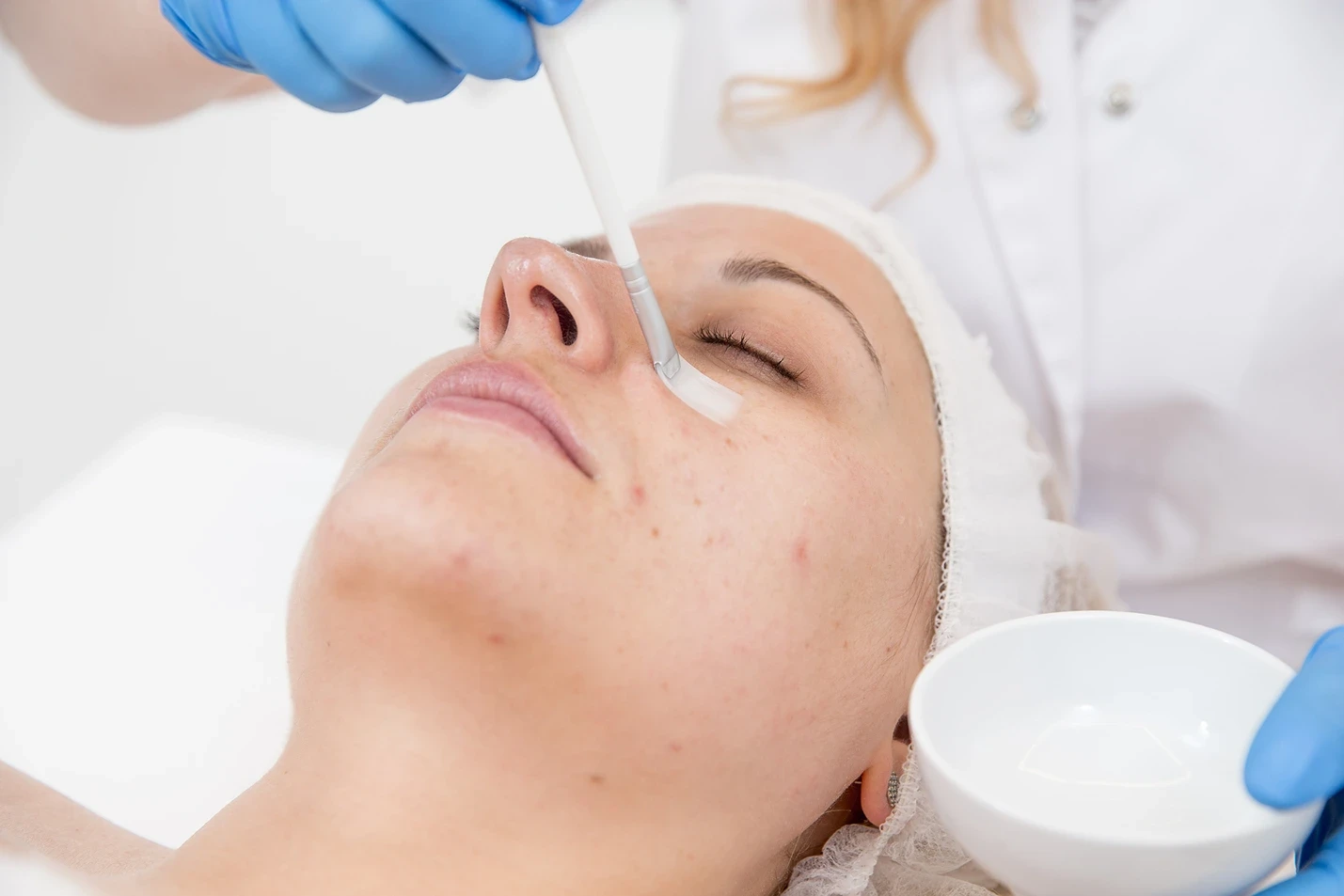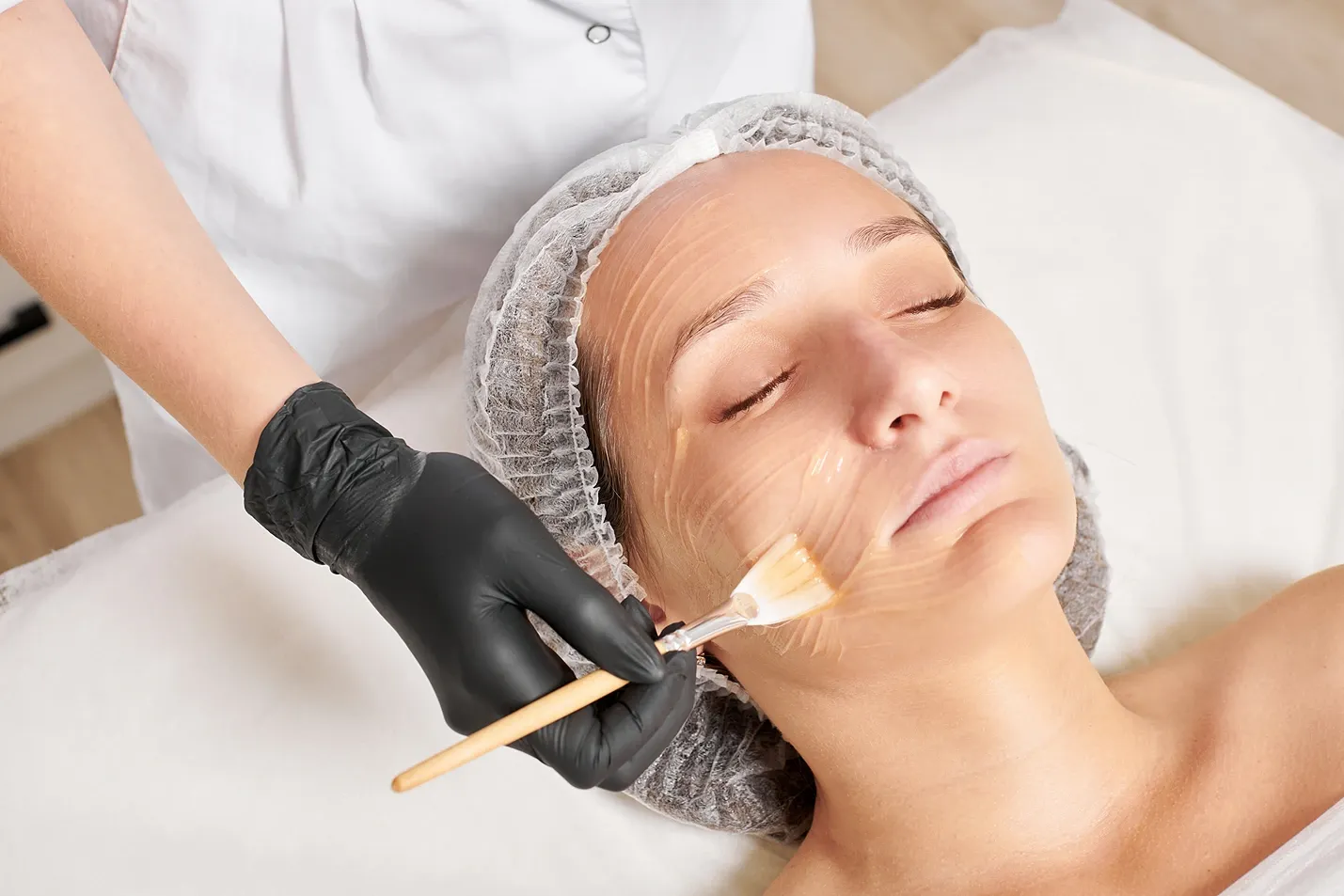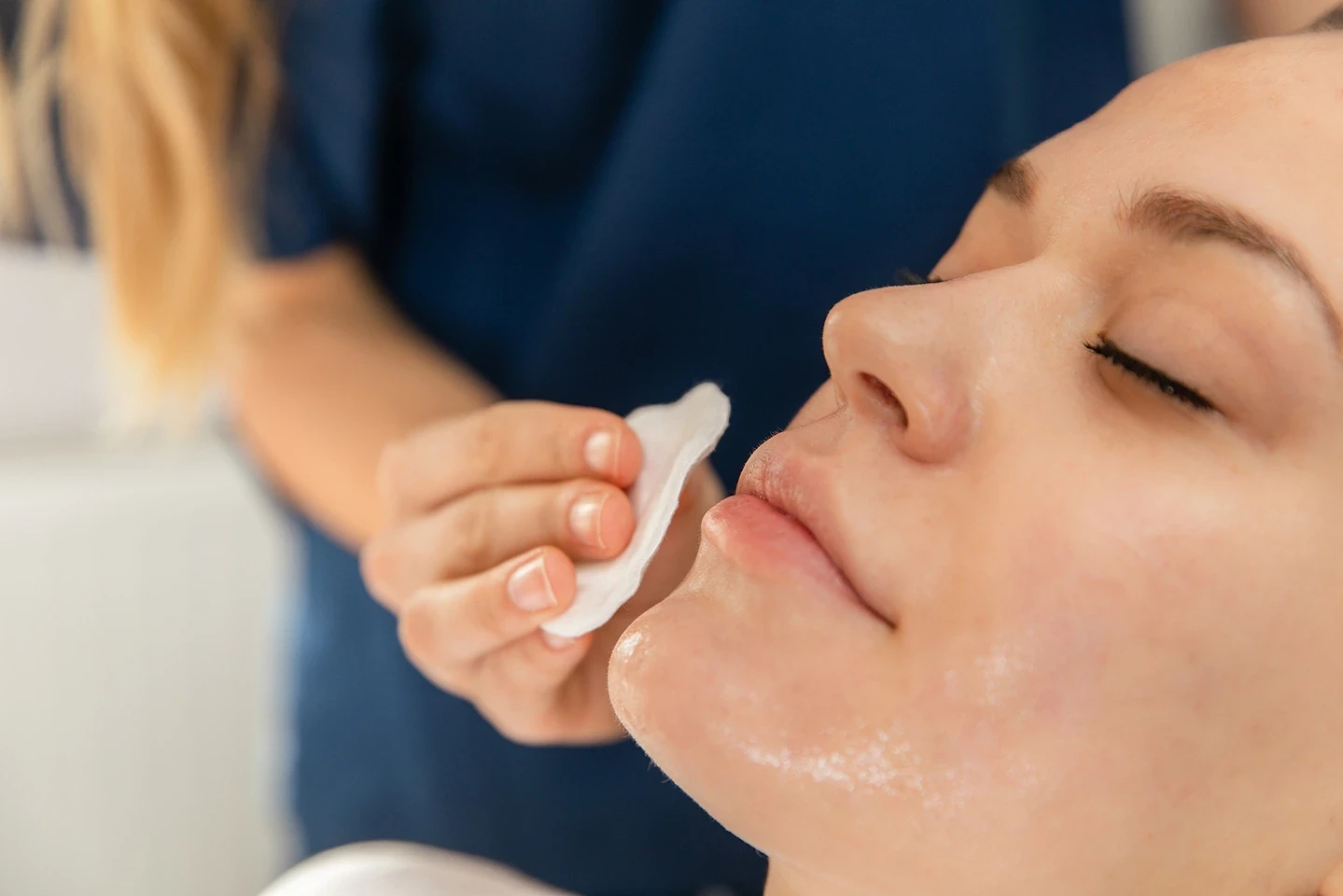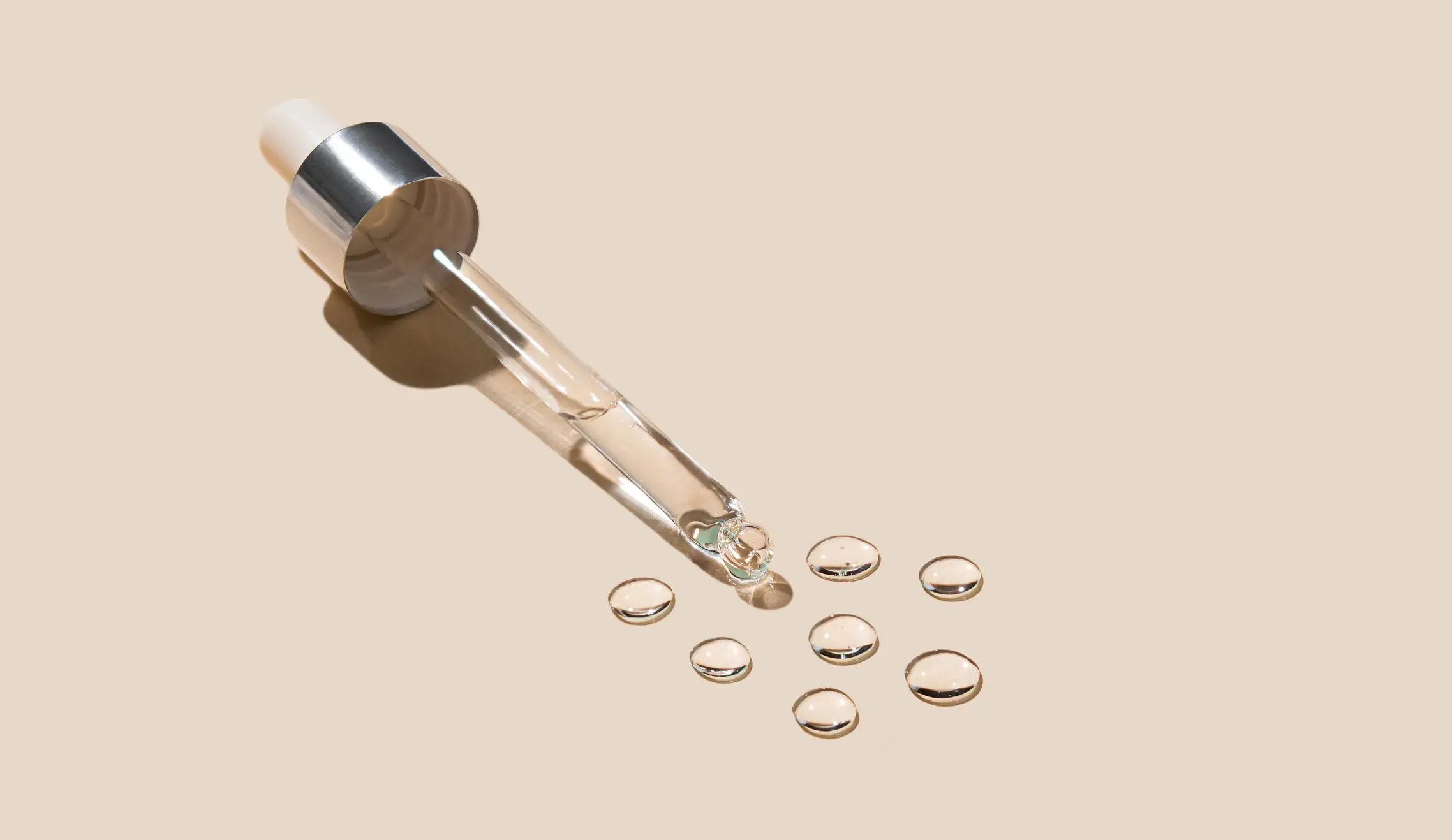Learn the average cost of chemical peels, as well as factors that can affect the price, such as the type of peel, the provider, and the geographic location
Are you looking to improve your skin’s appearance and texture? Then, a chemical peel might be your answer. It is a cosmetic procedure used to remove damaged or dead skin cells, revealing smoother, brighter, and more even-toned skin.
What is a Chemical Peel?
Chemical peels can vary in intensity, from a light peel to a deep one, and they use various chemical solutions to exfoliate different layers of the skin. In this article, we will discuss everything you need to know about chemical peels, including the cost of the procedure.
How Much Does a Chemical Peel Cost?
If you’re looking to improve the appearance of your skin, a chemical peel could be a viable option. This cosmetic procedure is designed to target a range of skin issues, including acne scars, sun damage, uneven skin tone, dark spots, and fine lines, among other skin imperfections.
Before you decide whether a chemical peel is right for you, it’s important to understand the cost involved. The average cost of a chemical peel varies depending on the type of peel, the size of the treatment area, and the expertise of the practitioner.
There are different types of chemical peels available, ranging from superficial peels to deep chemical peels. Superficial peels, also known as light peels, are the mildest type of peel and cost between $150 and $300 per treatment.
They use alpha-hydroxy acid or salicylic acid to target the outer layer of the skin. Medium peels, also referred to as medium-depth peels, range in price from $300 to $900. These peels use trichloroacetic acid (TCA) to penetrate deeper below the skin surface and treat more severe issues, such as fine lines, sun damage, and skin discoloration.
In contrast, deep peels, which use phenol solution, can cost upwards of $2,500 and are reserved for more extreme cases of sun damage or skin conditions such as acne scarring or deeper wrinkles.
It’s worth noting that the cost of a chemical peel can vary depending on the type of chemical solution used. For instance, phenol peels are the most expensive due to their deep penetration and potential for higher risk. Salicylic acid peels, on the other hand, tend to be less expensive compared to TCA and phenol peels, as they work on the surface layer of the skin.
Aside from the type of peel and type of chemical solution used, the extent of the treatment area can also impact cost. Larger areas such as the entire face or chest will naturally cost more than smaller areas such as a single spot on the face. Additionally, the intensity of the peel may also affect cost, as a deeper, more intense peel may require additional treatment sessions and result in an extended recovery time.
Finally, it’s important to consider the potential side effects of a chemical peel. Although rare, some people may experience scarring, infection, or changes in skin color. These side effects may increase the cost of treatment as additional procedures may be needed to address them.
Benefits of Chemical Peels for Skin
Chemical peels are a popular cosmetic procedure that can help improve the overall appearance and health of your skin. Whether you’re dealing with acne scars, uneven skin tone, dark spots, or sun damage, a chemical peel can effectively treat these issues by removing damaged skin cells and promoting the growth of new, healthy skin. In this article, we’ll dive into the many benefits of chemical peels for skin and why they’re worth considering as part of your skincare routine.
Improved Appearance of Acne Scars
If you’re dealing with acne scars, you may be searching for a solution that can help improve their appearance. One option worth considering is chemical peels. These cosmetic procedures can help resurface the outer layer of your skin and stimulate collagen production in the deeper layers, leading to a smoother and more even complexion.
There are different types of chemical peels that can be used to treat acne scars. Superficial or light peels are the mildest option, involving the use of alpha-hydroxy acids like glycolic acid and salicylic acid to exfoliate the outer layer of dead skin cells. These peels can help improve the texture and pigmentation of mild acne scars.
Medium peels, also known as medium-depth peels, penetrate deeper to address moderate acne scars. Trichloroacetic acid is the most common chemical solution used in this type of peel. While medium peels come with a longer recovery time than light peels, the results may be more substantial as they can penetrate deeper layers of the skin.
Deep peels, on the other hand, are the most intense type of peel, involving the use of phenol peels to resurface the skin layers. A deep chemical peel can significantly improve the appearance of deep acne scars, but it also comes with a higher risk of side effects and longer recovery time.
When it comes to choosing the right type of peel, it’s essential to consider your skin type and color. Ethnic skin, for example, can be more prone to hyperpigmentation and scarring, so using the right type of peel is crucial. It’s best to consult with a professional at a reputable skin clinic to determine the most effective treatment plan for your unique skin condition.
Reduced Uneven Skin Tones
If you’re looking for an effective way to reduce uneven skin tones, chemical peels might be worth considering. The chemical solution used in the peel process targets damaged skin cells in the outer layer, helping to stimulate the growth of new, healthier skin cells and provide a clearer and more radiant complexion.
There are various types of chemical peels that cater to different skin types and concerns. Alpha-hydroxy acids (such as glycolic and lactic acid), trichloroacetic acid (TCA), and phenol are some of the most commonly used chemical solutions in peels.
Alpha-hydroxy acids are gentle and suitable for most skin types. They work on the surface of the skin to remove dead skin cells, thereby reducing the appearance of fine lines, sun damage, and uneven skin tone.
TCA is a stronger solution than alpha-hydroxy acid, making it more effective for skin issues such as acne scars, fine lines, and dark spots. It penetrates deeper into the skin, which can result in a more significant improvement in skin texture but may also require a more extended recovery time.
Phenol is the most potent chemical solution, and it is generally reserved for deep chemical peels. It can effectively address sun damage, deep wrinkles, and even precancerous growths on the skin. However, it is not typically recommended for darker skin tones due to its potential for causing skin discoloration.
Clear Dark Spots or Discoloration
Are you struggling with dark spots or skin discoloration? One effective solution to consider is a chemical peel. Chemical peels work by removing the outer layer of damaged skin cells to reveal fresher, younger-looking skin underneath.
In the case of dark spots or discoloration, the chemical solution in the peel can penetrate into the deeper layers of skin where the pigmentation is located and break it up. This results in a more even skin tone and a reduction in the appearance of dark spots.
Salicylic acids, glycolic acid peels, and medium-depth peels are some of the commonly used chemical peels for treating dark spots and discoloration. These peels differ in their strength and the depth of penetration. It is essential to consult with a professional to determine which peel is best suited for your skin type and condition.
While chemical peels can be effective in improving the appearance of dark spots and skin discoloration, it is important to note that the extent of improvement largely depends on the individual’s skin condition and the depth of the discoloration. In some cases, a series of peels may be required to achieve the desired results.
Smoothing Rough Textures and Fine Lines
If you are looking to smooth rough textures and fine lines on your skin, chemical peels might be just what you need. A chemical peel is a cosmetic procedure that involves the application of a chemical solution to the skin, which removes the outer layer of damaged skin cells, revealing smoother, younger-looking skin underneath.
Chemical peels are particularly effective at reducing rough textures and fine lines because the chemical solution penetrates deep into the skin, removing dead skin cells and damaged skin. This process stimulates the growth of new skin cells, resulting in a smoother texture and visibly reduced fine lines.
Medium-depth peels and glycolic acid peels are some of the most effective chemical peels for this purpose. Medium-depth peels, as the name suggests, penetrate deeper into the skin, making them more effective at treating rough textures and fine lines. Glycolic acid peels, on the other hand, are milder and work by exfoliating the skin, giving it a smoother texture.
It is worth noting that achieving optimal results in reducing fine lines and rough textures may require multiple sessions. This is because the deeper the damage, the more sessions you may need to achieve a significant improvement in your skin’s texture. However, it is important to consult with a professional to determine which treatment plan is best suited to your skin type and condition.
Different Types of Chemical Peels Explained
Chemical peels come in various types, each specifically designed to target different skin issues. In this article, we’ll explain the different types of chemical peels available and what skin issues they address. Whether you have dark spots, fine lines, or sun damage, there is a chemical peel suited to your needs. Let’s take a look.
Light Chemical Peel (Superficial)
Are you looking for a quick and easy way to rejuvenate your skin? A light chemical peel treatment might be just what you need! In this article, we’ll cover everything you need to know about superficial chemical peels.
A light chemical peel is a milder version of the more intensive chemical peel treatments. This cosmetic procedure targets the outermost layer of skin, using a chemical solution such as alpha-hydroxy acid or salicylic acid to gently exfoliate away dead skin cells. Light chemical peels are sometimes referred to as superficial chemical peels.
The procedure is straightforward and typically only takes around 30 minutes. During the treatment, the chemical solution is applied to the skin and left on for a short period of time before being washed off. Patients might feel a slight tingling sensation, but the process is generally painless.
Like all cosmetic procedures, light chemical peels carry some common side effects. These may include skin irritation, redness, and peeling. It’s important to note that these symptoms are usually temporary and should subside within a week or so.
Another advantage of light chemical peels is that the recovery time is relatively short. Generally, patients can expect a few days of mild redness and peeling before they can go about their usual activities. It’s best to avoid direct sunlight during the recovery period and use a suitable SPF.
So, what skin types benefit from this treatment? Light chemical peels are suitable for all skin types, including darker or ethnic skin tones. Patients with uneven skin tone, age spots, dark spots, or mild sun damage may see the most improvement from the procedure.
Medium Depth Chemical Peel Cost
Are you looking for a cosmetic procedure to target deeper layers of your skin? A medium depth chemical peel may be just what you need. Unlike light chemical peels, this type of peel penetrates deeper into the skin to treat a variety of skin conditions such as sun damage, uneven skin tone, and deep wrinkles.
However, before undergoing a medium depth chemical peel, it’s important to consider the cost. On average, this type of procedure can range anywhere from $500 to $1,500, depending on the location and the clinic you choose. Some high-end clinics may even charge up to $3,000.
It’s important to note that while cost may be a factor in your decision-making process, it’s equally important to choose a qualified and experienced professional to perform the procedure. This will not only ensure the best possible results but also minimize the risk of adverse effects.
If you have dark spots or damaged skin cells, a medium depth chemical peel may be the right treatment for you. However, it’s essential to consult with a healthcare professional to determine if it’s a suitable option for your skin type.
Deep Chemical Peel Cost
A deep chemical peel is a cosmetic procedure that uses a chemical solution to remove the outer layer of skin, revealing fresher and younger-looking skin underneath. This type of chemical peel is recommended for individuals with more severe skin conditions, like deep acne scars or sun damage. However, one crucial factor to consider before undergoing this treatment is the cost.
On average, a deep chemical peel can range from $1,500 to $4,000, but the price may vary based on location and clinic. It’s worth noting that some high-end clinics may charge upwards of $6,000 for this procedure. So before you commit to a deep chemical peel, consider your budget and if it’s feasible for you.
However, while cost may be a factor, it’s essential to prioritize the quality of the clinic and the medical professional performing the procedure. Of course, you want the best possible results, but you also don’t want to risk adverse effects. So make sure to do your research and find a qualified and experienced professional to perform your deep chemical peel.
Additionally, keep in mind that deep chemical peel treatments often require weeks of recovery time, during which you may experience skin peeling, redness, and sensitivity. So it’s important to factor in any recovery time needed and to plan accordingly.
If you’re considering a deep chemical peel, it’s crucial to understand the procedure’s potential risks and benefits and to consult a healthcare professional to determine if it’s the right treatment for your skin type and condition. While cost may be a factor, it shouldn’t be the only consideration. Choose a reputable clinic and a skilled professional for the best possible results and a positive treatment experience.
How Do Chemical Peels Work?

You may be wondering how chemical peels work and if they’re right for you. Chemical peels are a cosmetic procedure that addresses various skin concerns such as acne scars, dark spots, uneven skin tone, and sun damage. The process involves using a chemical solution to remove the outer layer of damaged skin cells, revealing smoother skin underneath. There are different types of chemical peels, ranging from superficial to deep peels, and the type you choose will depend on your skin condition and desired results. But how exactly do chemical peels work? Let’s dive in.
Vi Peel
Are you struggling with skin imperfections such as acne scars, sun damage, or dark spots? If so, you might be interested in the Vi Peel. This medium-depth chemical peel is designed to address a variety of skin conditions and improve the overall appearance and health of your skin.
So, what sets the Vi Peel apart from other chemical peel treatments? While similar in some ways, the Vi Peel uses a unique blend of ingredients that work together to penetrate deep into the skin and remove damaged cells. Trichloroacetic acid, salicylic acid, and lactic acid are all included in the Vi Peel’s solution, which helps to exfoliate and remove the outer layer of skin. This process can reveal brighter, smoother skin and improve the appearance of imperfections that exist deeper in the skin.
The Vi Peel also contains a special blend of vitamins and minerals, which work in conjunction with the chemical solution to nourish and rejuvenate the skin. This combination of ingredients helps to improve the overall health and appearance of the skin, leading to a glow that lasts longer than just a superficial treatment.
If you’re interested in the Vi Peel, it’s important to note that it is a medium-depth chemical peel. This means that there is some downtime associated with the procedure and you should plan for several days of recovery time. However, the results can be significant and last longer than some other types of peels.
Alpha-Hydroxy Acid (AHA Peel)
If you’re looking to refresh your skin and get rid of fine lines, dryness, and uneven pigmentation, Alpha-Hydroxy Acid (AHA) Peels may be the answer. AHA Peels use a different blend of ingredients than other chemical peels, making them a popular choice among those seeking a quick cosmetic procedure that yields noticeable results.
Thanks to the AHAs in the peel solution, AHA Peels can penetrate deeper into the layers of the skin, exfoliating and buffing away dead skin cells. This deep penetration is why AHA Peels are so effective in treating fine lines, dry skin, and uneven pigmentation that other superficial peels aren’t capable of addressing.
During the application process, a trained professional will clean and prep your skin, applying the AHA solution to your face. The solution stays on for a short period before it’s removed, revealing the newly treated skin underneath. Recovery time for an AHA Peel is typically around one to two weeks, during which time you’ll need to be careful not to expose your skin to the sun or harsh chemicals.
The two most common types of AHAs used in peels are glycolic acid and lactic acid. Each acid has unique benefits. Glycolic acid, the smallest AHA molecule, can penetrate deeply into the skin, improving the texture and appearance of fine lines and wrinkles. On the other hand, lactic acid is a gentle AHA and works best for those with sensitive skin and mild pigmentation issues. It helps improve skin texture by stimulating collagen production.
It’s essential to note that AHA Peels do have some side effects. After a peel, you may experience redness, irritation, and sensitivity to the sun. You may also notice some flaking and peeling of the skin. These side effects are completely normal and can be reduced by using sunscreen and keeping your skin moisturized.
Trichloroacetic Acid (TCA Peel)
Trichloroacetic Acid (TCA Peel) is one of the most commonly performed medium-depth peels to treat several common skin conditions, including fine lines, uneven skin tones, and acne scars. TCA peel is highly effective compared to its superficial counterparts because it penetrates throughout the outer layer of the skin and reaches the deeper layers for much more effective results.
The TCA peel process starts with cleaning the patient’s face, followed by the application of the chemical solution to the skin. The solution gradually penetrates the outer layer of the skin and reaches the deeper layers, effectively breaking down dead skin cells and promoting new skin cell growth. The skin may start to peel after a few days as the damaged skin cells start to shed, revealing new, healthier skin underneath.
Different concentrations of TCA peels are available, ranging from superficial, which penetrates only the outer layer of the skin to deep skin peels that may cause significant damage to the skin. Superficial peels are ideal for treating minor skin conditions like mild pigmentation, while deep peels are recommended for severe skin conditions.
Several factors may affect the TCA peel cost, including the expertise of the practitioner, the size of the treated area, the type of peel, and the location. An experienced and qualified practitioner with a good reputation may charge more than a lesser-known practitioner. Treatments targeting large areas of skin tend to be more expensive than those that focus on small areas.
Phenol Peel
Have you ever heard of a phenol peel? It might not be as well known as other types of chemical peels, but it’s the deepest and most intensive peel available. This type of peel isn’t for everyone, but it can be incredibly beneficial for individuals with severe skin conditions.
Phenol peels are ideal for treating deep wrinkles, scars and sun damage. The phenol solution is a strong chemical that penetrates the outer layer of skin and effectively breaks down damaged skin cells, revealing fresh, healthy skin underneath.
However, it’s important to note that phenol peels come with significant peeling and discomfort during recovery. Recovery time can also take several weeks, and it’s not recommended for individuals with darker skin tones due to the risk of hyperpigmentation.
If you’re considering a phenol peel, it’s essential to find a qualified and experienced practitioner. The cost of the treatment may vary depending on the area being treated, the practitioner’s expertise, and your location.
What Does the Chemical Peel Cost Depend On?
Chemical peels are becoming increasingly popular for their ability to improve a variety of skin conditions, including acne scars, dark spots, uneven skin tone, and sun damage.
One thing that many people consider before getting a chemical peel is the cost. While the average price ranges from $150-$300, the exact cost depends on several factors.
The Intensity of the Peel
Chemical peels are a popular cosmetic procedure that uses a chemical solution to remove damaged skin cells, promote cell regeneration, and improve the skin’s appearance. One of the essential factors that determine the cost and results of a chemical peel is the intensity of the peel.
The intensity of the peel refers to how deeply the chemical solution penetrates into the layers of skin. A light chemical peel is the mildest option that only affects the outer layer of skin. It uses a mild acid, such as alpha-hydroxy acid (AHA), to exfoliate the skin gently and improve its overall texture and tone.
While a light chemical peel may require several treatments to achieve optimal results, it is a quick and easy procedure that usually takes less than 30 minutes and has very minimal downtime. The cost of a light chemical peel is generally more affordable than a medium or deep peel, making it a popular choice among patients who have mild acne scars, fine lines, and uneven skin tone.
A medium chemical peel uses a stronger acid, such as trichloroacetic acid (TCA), to penetrate deeper into the skin. This type of peel can reach the middle layer of the skin, resulting in a more dramatic transformation of the skin’s appearance. However, it also comes with a higher risk of side effects, such as scarring, hyperpigmentation, and prolonged redness and swelling.
Since a medium chemical peel is more intensive than a light peel, it requires longer downtime and may take several weeks to recover fully. The cost of a medium chemical peel is relatively higher than a light peel, but it is still generally affordable for most patients.
A deep chemical peel uses a potent acid, such as phenol, to penetrate the skin’s deepest layers. This type of peel can significantly improve the appearance of deep wrinkles, severe sun damage, and dark spots, but it also comes with the highest risk of side effects. A deep peel requires several weeks of recovery time and often needs to be performed under light anesthesia.
The cost of a deep chemical peel is generally the highest due to its intensive nature, but it provides the most significant and long-lasting results. It is typically recommended for patients who have severe skin conditions and have exhausted all other treatment options.
Type of Peel
Chemical peels are a popular cosmetic procedure that can improve the appearance of the skin by removing the outer layer of damaged skin cells. They come in different types that vary in strength and depth, making it important to understand the differences between the types of peels available.
Superficial peels, also known as light chemical peels, are the mildest option and only remove the outermost layer of skin. These peels are typically used to treat acne-prone skin, reduce the appearance of fine lines, and improve the skin’s texture and brightness. They utilize milder acids such as glycolic acid, lactic acid, and salicylic acid.
Medium-depth peels, such as trichloroacetic acid (TCA) peels, penetrate the middle layer of the skin and are used to treat skin discoloration, uneven skin tone, and fine lines and wrinkles. These peels require slightly longer recovery periods than superficial peels and yield more dramatic results.
The deepest types of peels are the deep chemical peels, which use phenol as their active ingredient and penetrate the skin’s lower layers. They are reserved for people with severe skin conditions, such as age spots, deep wrinkles, and scars. While these peels can provide the most dramatic results, the recovery period is the longest and requires anesthesia.
Before choosing a type of chemical peel, it is essential to consider your individual skin type and consult with a trained professional to determine which type of peel is best suited for your unique skin condition. While superficial chemical peels can often be performed safely at home, it is more important to seek a licensed dermatologist for deeper peels to avoid unnecessary risks.
The Expertise of the Practitioner
When considering getting a chemical peel, it’s not just the type of peel you need to think about; it’s also the expertise of the practitioner performing the treatment. The effectiveness of a chemical peel can greatly depend on the qualifications and experience of the person performing it.
To ensure that the practitioner is qualified and experienced enough to carry out a successful chemical peel, there are a few requirements that should be met. Firstly, they should have a medical license that enables them to perform cosmetic procedures. A licensed practitioner will have gone through the necessary training and certification to ensure they are qualified to practice their craft.
Secondly, they should have experience performing chemical peels and a track record of successful treatments. A practitioner who has performed numerous chemical peels on a variety of skin types and conditions will have a wealth of experience to draw upon when performing your treatment.
Lastly, the practitioner should have education and training specific to the field of chemical peels. They should be knowledgeable about different skin types and conditions, as well as the various types of chemical peels available. This education and training can help to ensure that the practitioner is able to tailor the treatment to your individual needs.
Size of the Area Treated
When considering the cost of a chemical peel, the size of the area being treated is an important factor to keep in mind. As a general rule, the larger the surface area of the skin that needs treatment, the higher the cost of the chemical peel will be. This makes sense when you consider that a larger area will require more solution and will potentially involve more time and expertise to perform the treatment.
In addition, the size of the area being treated can also impact how many subsequent peel sessions are required. For example, if a patient has a large area of acne scarring or uneven skin tone, it may take multiple peel sessions to fully address the issue. This could further affect the total cost of the treatment.
When seeking a cost estimate for a chemical peel, it’s important to take into account the size of the area being treated. An experienced practitioner will be able to provide an accurate estimate based on the specific needs of each patient.
Expertise in identifying the appropriate amount of solution to apply is crucial to ensuring that the patient receives a chemical peel that is safe, effective and affordable. A skilled practitioner will be able to assess the patient’s skin type, condition and the size of the area being treated to determine the optimal approach.
Location
The location of a skin clinic or practitioner can greatly impact the cost of a chemical peel. This is because the cost of living varies widely depending on the country, state, or city in which the clinic is located. As a result, the price of cosmetic procedures may also fluctuate.
If a skin clinic is situated in a prestigious area known for luxury and exclusivity, the cost of their services may be higher to reflect their location. On the other hand, there are clinics that offer discounts for chemical peels due to their location. For example, a clinic located in a more rural or less populated area may have lower overhead costs and be able to offer chemical peels at a lower price.
Another factor that may affect the cost of chemical peels is the availability of experienced practitioners in a certain location. If a particular area has a high demand for cosmetic procedures and a shortage of experienced practitioners, the cost of chemical peels may be higher to reflect the demand and scarcity of resources.
Finally, it’s important to note that the location of a skin clinic or practitioner may also impact the level of quality and technology available. A clinic located in a major metropolitan area may have access to the latest and most innovative equipment, while a clinic in a more remote area may not have the same level of technology available. This may impact the cost of chemical peels, as clinics with better equipment and technology may charge more for their services.
Add-On Services
When considering a chemical peel treatment, you may come across the option of add-on services. These additional treatments are often marketed as enhancing the effects of the peel, providing extra benefits to the skin, or even helping you relax during the procedure.
Some of the popular add-on services include facial massage, light therapy, lymphatic drainage, and collagen infusion. Facial massage can help boost circulation, promoting healthy blood flow to the skin. Light therapy uses specific wavelengths of light to stimulate collagen production and reduce inflammation. Lymphatic drainage can eliminate toxins from the body and reduce swelling. Collagen infusion can help improve the skin’s elasticity and hydration.
It’s essential to note that not all clinics offer these add-on services, and they may come at an additional cost on top of the chemical peel cost. Therefore, it’s best to first ask your practitioner about the availability, benefits, and costs of add-on services before making your purchase.
The cost of these add-on services can vary greatly depending on the specific treatment and the location of the clinic. For example, a 30-minute facial massage or light therapy session may cost around $50, and lymphatic drainage may add up to $100. Meanwhile, collagen infusion can cost about $300 or more.
Number of Sessions

For optimal results, the number of sessions required for a chemical peel treatment can vary depending on the type of peel chosen.
Light peels, for instance, can often be performed every two to four weeks and may require a series of three to six treatments. If you’re looking for deeper improvement, medium depth peels may require two to three sessions, spaced apart by several months, depending on the condition of your skin and your desired level of improvement.
However, if you opt for a deep peel, keep in mind that due to the significant effect on the skin, it may only be performed once. It’s essential to consult with your practitioner to determine the right type of peel and the ideal number of sessions for your skin type and condition. Remember that a chemical peel is a cosmetic procedure that requires adequate recovery time between sessions to let your skin heal fully.

